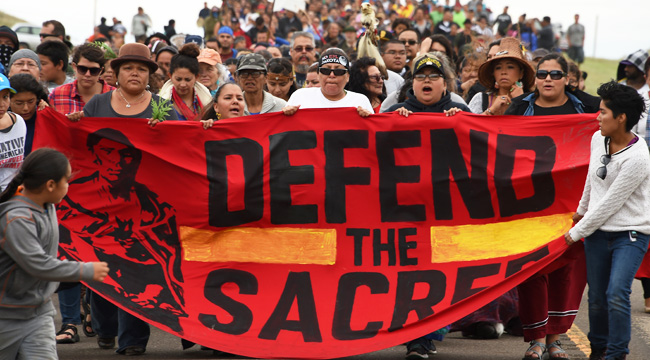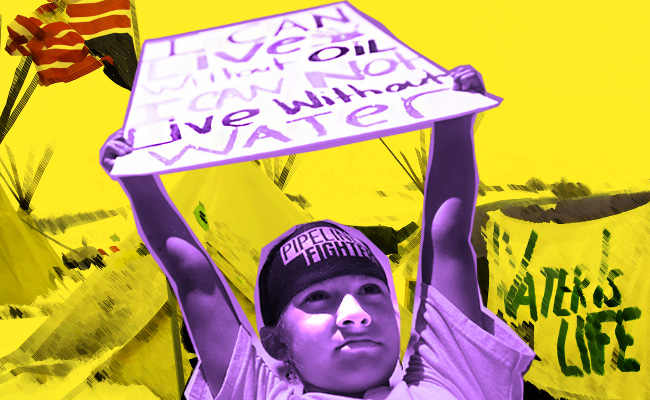
The election of Donald Trump continues to provide ripe fodder for the media while pulling focus from an important saga taking place up in North Dakota, where the Standing Rock Sioux Tribe has been leading an ongoing battle over water rights and the preservation of what the tribe considers to be sacred land. Though the Dakota Access Pipeline construction is a relatively new development, it touches upon a conflict that has been brewing for centuries, and those known as “water protectors” are now displaying unprecedented resistance.
Though the mainstream media coverage of the ongoing movement has been sparse, the effects may be historic. The Sioux and their supporters have been greeted with not only tear gas from riot-gear clad officers but attack dogs, rubber bullets, and even water cannons that have been deployed in below-freezing weather. The latter method may cost one woman her arm after it was, according to her family, nearly blown off her body. And on Monday, several protesters filed an excessive force lawsuit against law enforcement officials.
It’s worth noting that the protests have been characterized by authorities as “riots” despite no weaponry being carried by the Native Americans. All known attacks have been carried out by either government-sanctioned forces or the pipeline construction crews. This violence began in September and continued throughout Thanksgiving weekend in a manner that’s almost as ironic as the contemporary holiday celebrations themselves.
Standing Rock contends that the pipeline will destroy sacred burial ground and not only contaminate their water supply but the drinking water of millions of other U.S. citizens. These fears are not unfounded. The Pipeline and Hazardous Materials Safety Administration has recorded 3,300 oil and gas pipeline leaks in the U.S. since 2010. On average, that’s more than one leak per day, and one must also consider the size of this project. According to the Dakota Access Pipeline fact sheet, the finished project would transfer up to 570,000 barrels of crude oil each day.
For perspective’s sake, the Yellowstone River fell prey to a January breach in the Poplar pipeline system, which transfers about 42,000 barrels per day. This disaster dumped 1,200 barrels of crude oil daily into the water. A breach from the Dakota Access Pipeline could be at least ten times worse. Even a small spill would contaminate the river, and a large spill would be catastrophic. Beyond water, which is life, there’s the question of treaty violation, which only reinforces the centuries of mistreatment known by Native Americans.

Allegations Of Treaty Violations
The overarching issue of Native American sovereignty runs parallel to environmental concerns here. The crude oil pipeline began as a mammoth $3.8 billion project, which would stretch 1,172 miles from North Dakota’s Bakken oil fields and traverse through South Dakota and Iowa all the way to Illinois. Notably, the original path would have crossed the Missouri River near Bismarck. However, this predominantly white city rejected the path out of oil-spill fears. So, the project rerouted the point of water crossing southward, which lands just north of Standing Rock’s reservation. In response, the Sioux established a camp on the Missouri River’s banks in April.
The Sioux argue that the pipeline crosses sacred burial grounds. Although the land in question is technically private property owned by the pipeline developer (and does not involve reservation land), the proposed pipeline route would run under the Missouri river, half a mile away from the reservation. And a New York Times report notes how “the pipeline crosses disputed Sioux land that was promised to the tribe in the 1851 Treaty of Fort Laramie but was later taken away.” A recent NY Times op-ed also summarized the symbolic nature of the conflict:
The confrontation cannot help summoning a wretched history. Not far from Standing Rock, in the Black Hills of South Dakota, sacred land was stolen from the Sioux, plundered for gold and other minerals, and then carved into four monumental presidential heads: an American shrine built from a brazen act of defacement.
The Sioux know as well as any of America’s native peoples that justice is a shifting concept, that treaties, laws and promises can wilt under the implacable pressure for mineral extraction. But without relitigating the history of the North American conquest, perhaps the protesters can achieve their aim to stop or reroute the pipeline.
The Fort Laramie treaty meant to bring peace between whites and the Sioux settlers of the Dakota Territory’s Black Hills. The stated conditions included the northern border of the Heart River that (per the Denver Post) “winds up to Bismarck, about 25 miles north of the Cannonball River that was declared the northern border by an act of Congress in 1889.” The clashes between protesters and authorities over the pipeline have all occurred very close to the Cannonball. This arguably violates the treaty that aimed to preserve Native American lands and sovereignty as well as prevent the struggle we’re seeing today.
Recently, the U.S. Army Corps of Engineers ordered protesters to clear the camp by December 5 or be subject to prosecution for trespassing on “Corps-managed land.” The Corps cites “violent confrontations between protestors and law enforcement officials” and the “harsh North Dakota winter conditions” as reasons for the ban. The order arrived on Thanksgiving, a move that evokes hundreds of years of Native American suffering.
Despite the orders, Oglala Sioux member Isaac Weston told NBC News he will not budge: “We are wardens of this land. This is our land, and they can’t remove us.” On Tuesday, authorities blocked supplies and access to the camp in an effort to force evacuations. And with the December 5 deadline moving closer, a group of 2,000 veterans have vowed to act as human shields to hinder authorities from forcibly ejecting the protesters.
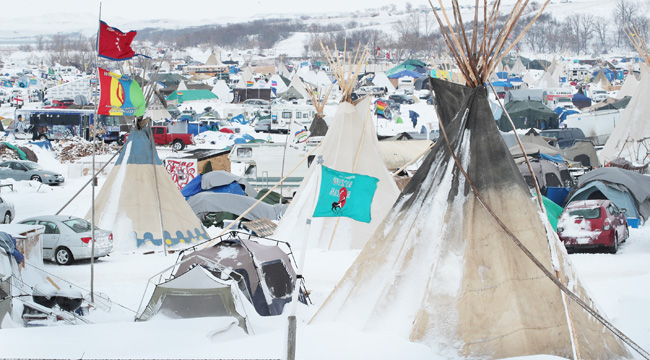
The Importance Of Standing With Standing Rock
Reverend Lennox Yearwood is the President and CEO of the Hip Hop Caucus. Yearwood and his organization (which counts Vic Mensa, who visited Standing Rock, as a spokesperson) regularly defend embattled communities, most recently while the Voting Rights Act was trounced in multiple states.
The organization aims to defeat oppressive maneuvers from existing power structures, and the caucus (that acted as part of the successful fight against the Keystone XL extension) joined the movement against the pipeline’s proposed route. Here’s a photo of Taboo Nawasha (of the Black Eyed Peas) with Yearwood at a recent Standing Rock benefit, held by the Hip Hop Caucus.
During this post-election haze — while many are either performing a victory dance or wallowing within a pit of depression — Yearwood, a military veteran who recognizes climate change as an issue of national security, does not rest. His unyielding optimism is infectious, and he maintains hope for the peaceful resistance,
We spoke with Reverend Yearwood last week and originally aimed to discuss Trump’s climate change policy. Unfortunately, Trump’s position on the issue is not a deep one and will likely soon change, so we moved beyond that subject.
Yearwood remains optimistic that Trump’s victory will inspire a transformation that will overcome the “fear and negativity” of what some supporters perpetuate in his name.
“From the n-word to you name it, it’s an endless amount of hate happening in a very short time,” Yearwood told UPROXX. “It’s only been two weeks! [laughs] Literally in two weeks, there’s been about 500 cases of hate crimes. It is a thing that we definitely need to correct.”
The case can be made that much of the hatred comes from a subset of Trump supporters, who embody a deep-seated disrespect for minorities, which is also reflected in the attitudes of law enforcement and private interests towards Standing Rock. Yearwood has visited the area numerous times since the movement began. What our conversation ultimately yielded was a glimpse into life at Standing Rock, beyond the fleeting images we view on social media (actor Matt McGorry claims that cell signals are being scrambled to hinder sharing efforts of people at the site). And although the movement has trended on Twitter for months (under the #NoDAPL hashtag), the mainstream media largely ignored the trend.
On the subject of climate change as well as Standing Rock, Yearwood hopes that Trump will “realize that this is not about profits but about people.” Still, Trump favors fossil fuel reliance (for purposes of job creation and profits), and he reportedly holds stock shares in Phillips 66, which owns about one-quarter share of Dakota Access.
You’ll recall that favoring profits over people lead to injustices like Flint, MI where an entire community saw their water poisoned by aging lead pipes simply because it was less expensive to reroute the city’s water supply from a corrosive source.
As Yearwood hints, tools exist for anticipated future battles against Trump: “For those of us who have studied the Civil Rights Movement, you know, working in a hostile environment. We have seen that demonstration and litigation can be utilized in a very successful manner.”
And so, the Sioux have settled into the encampment in what’s being described as the largest tribal gathering in 100 years. Yearwood explains how the winterization of the camp is a constant process. “It’s a little cold up there as you can imagine,” he laughs.
Yet he paints a rather incredible portrait: “There are 4000 people who are now living there, and so they’re feeding over 4,000 people, their children are going to school at this active protest site, there are, you know, babies being born on the site, on the camp, so it’s an amazing place.”
Yearwood explains how the daily routine begins with prayer, after which people set about winterizing the camp and preparing food while “some of the escalations are the most horrible things that’s been done by the police.” He feels these abuses are “very embarrassing for our country.”
Weapons are being deployed against the Standing Rock people on a nightly basis, according to Yearwood. However, “the people, the water protectors, are not using these weapons, and it shows to me how powerful they are. Because they’re using their spiritual guides and aspect, and they’re not only doing it for themselves. Clearly, they are putting… they’re fighting for clean water for over 17 million people, most of whom are not Native people.”
He feels that Standing Rock gives the American people a lesson in resistance, “and for many of our usual, contemporary, US-based movements, really, they’re putting us to shame.” He believes that the use of spirituality and love, as well as nonviolent resistance, should bring their fight to national prominence. In particular, he singles out “how women have been so amazing and how they’re leading this movement, putting their bodies on the front lines.”
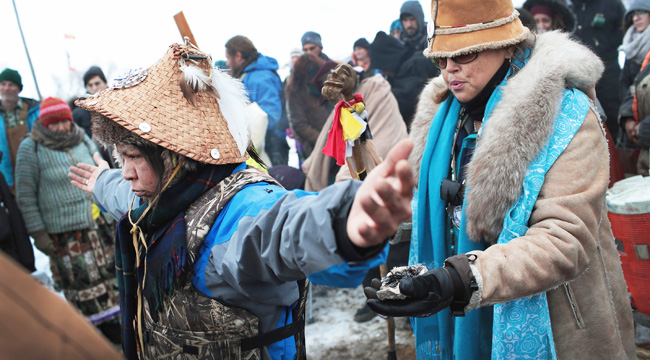
The Inherent Strength Of The “Water Protectors”
Although #NoDAPL rides on social media, and several high-profile celebrities (including Shailene Woodley, Mark Ruffalo, Neil Young, and the aforementioned McGorry) have stood in solidarity with the movement, the mainstream media coverage that this struggle has received has been uneven at best. With such a lack of clarity, terminology is important. For instance, while those authorities prefer to describe the Standing Rock encampment occupants as “rioters,” the media appears to favor “protesters.” And the movement itself prefers “water protectors.”
When asked about this distinction, Yearwood clarifies. “The camp itself is a protest,” he says. “And [that’s] very, very important to recognize, but what we’re witnessing [is] the structural violence that our country has waged and continues to wage on the Native Americans to this day. Now being backed up by the physical violence.” He believes this is the case “because the spiritual resistance of the people at Standing Rock is so strong. To me, it’s truly compelling because it makes plain the truth of the oppression and also shows the weakness of the oppressor.”
Yearwood expresses how the ultimate goal is to “keep it [the oil] in the ground” and to keep the movement running all winter long, as peacefully as possible.
“If this pipeline isn’t done by January 1st, in some cases, the money runs out,” he reasons. “They could just get more money, but according to their plan, the money runs out, and so, we’re making it much more difficult. We feel that yes, digging things out of the ground, I call it pollution, and with our planet in peril, that should be very difficult to do. For clean energy, it should be as easy as possible. So, the goal here is to make it as difficult as possible for us to rely upon fossil fuels.”
I bring up the so-called Bundy Militia members, who seized an Oregon wildlife refuge by armed force last winter. They were allowed to occupy and weren’t treated as a threat. Yes, one member was killed by law enforcement but only after he allegedly reached for a gun when his vehicle ran into an embankment. All militants were then cleared by a jury.
Yearwood finds the difference in how the government treats the two groups to be “very disturbing, clearly. It lays bare some of the hard pain of racism in this country, how people are treated differently.” He adds that the militants intruded upon federal land, as opposed to the Standing Rock movement: “This actually is their land that they’re fighting for. And I’ve heard that the folks at Dakota Access have the nerve to call these people ‘squatters’? Like man, how do you get that kind of gall?”
Yearwood sees the treatment as clear evidence of “bias in the system.”
The level of disrespect shown towards the water protectors is harsh, and Yearwood says of the Dakota Access company, “I’m not sure they expected … I think they assumed that the Native Americans would be the path of least resistance. And so it is almost shocking to them that they have the gall themselves to fight against their water being polluted and believing that water is life, that they are water protectors, and that everything comes from that. So I think that fuels the brutality, the lack of humanizing of how they have been approaching.”
Yearwood sees this as a continuation of the sadder aspects of U.S. history: “I think that how we look upon the Natives in this country has been horrible, and this continues that tradition.”
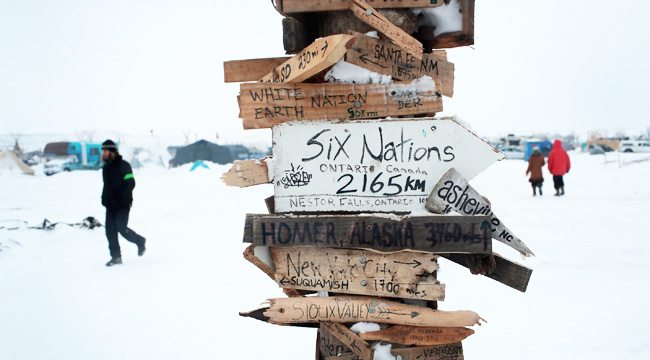
Reflecting On The Past And Moving Into The Future
In November 2015, President Obama rejected the proposed Keystone XL pipeline extension after a six-year battle over Nebraska’s Sandhills region. Yearwood led activists for years leading up to the decision, and he sees similarities between that fight and the current one.
He remembers how his friend, Van Jones, told him that the Keystone resistance was futile: “It was crazy, trying to fight Keystone. We fought, and we won.” Yearwood hopes that the Standing Rock people can convince President Obama not only to require another project reroute but “even to give him ideas — to make Standing Rock a national monument so they can’t build pipelines there.”
Yearwood knows that Standing Rock has attracted attention on multiple levels, and he feels that, if nothing else, this will help the climate movement move past a “kind of Birkenstock/kind of San Francisco” reputation and one that connects more to the general public. He’s excited at how the movement has, over the last few years, grown to broaden its attitudes when it comes to race, “allowing people of color, like myself” to lead. This change, he says, will position the movement for victory going forward (regardless of Standing Rock’s outcome), “particularly in this age of an administration that might be kind of hostile” towards environmental issues.
On behalf of the Hip Hop Caucus, Yearwood hopes Obama will soon make a decision, and he leaves a powerful final statement: “I’ll tell you this, the one thing this is so powerful about these people is that they truly believe in the power of the people. And one thing that is a theme in Standing Rock is that organized people beat organized money every single time. And I believe that will happen in this case.”
Hip Hop Caucus will host a virtual townhall on December 7, 2016 at 8:00 p.m. EST in their ongoing effort to support the #noDAPL movement and educate all Americans. The townhall will include Native American prayers, update on the current state of Standing Rock and the #NoDAPL protest, the environmental injustice implications of the pipeline, an introduction to Hip Hop Caucus, and how anyone can get involved. Rev. Yearwood, Taboo, hip hop star Vic Mensa and other artists will serve as panelists. The townhall can be accessed via RSVP here.
